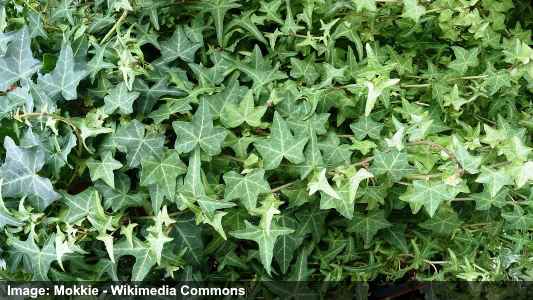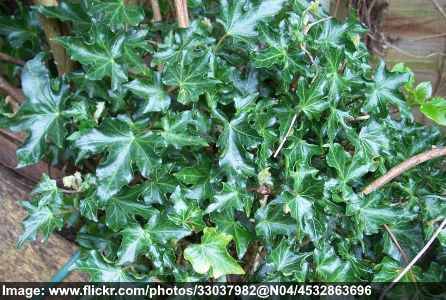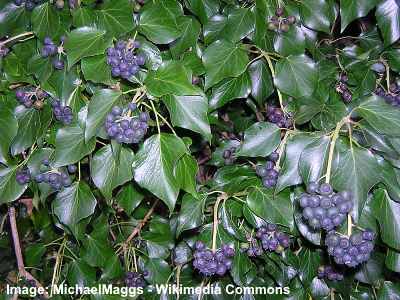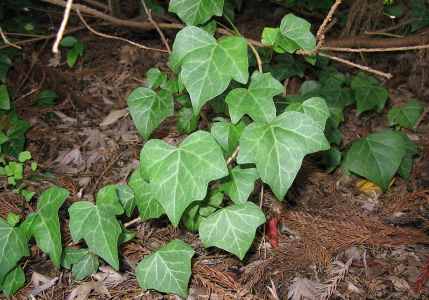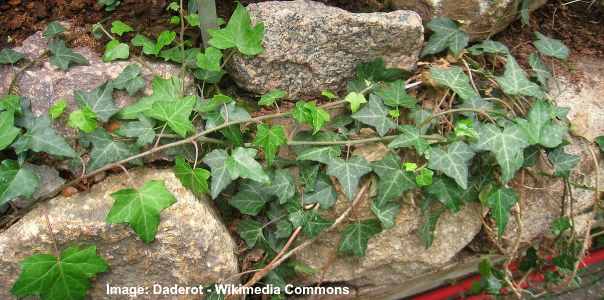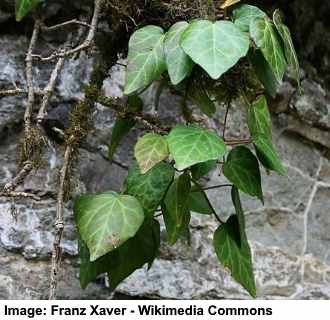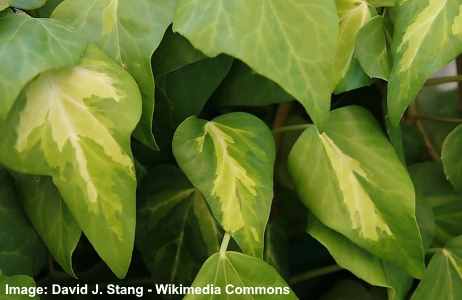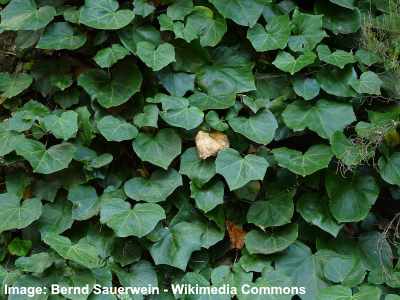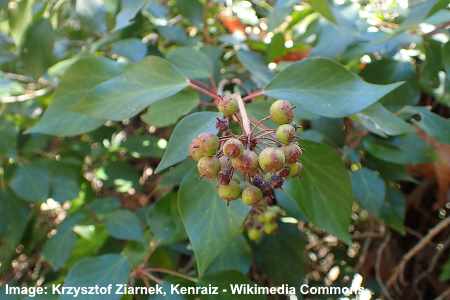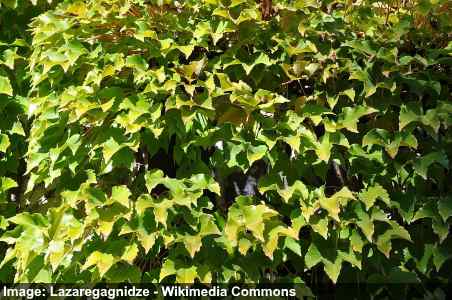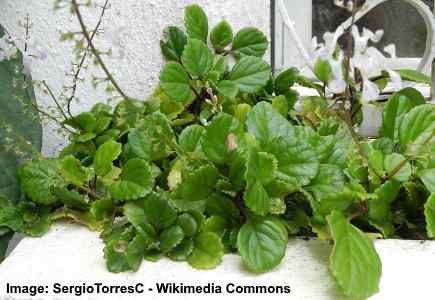Types of Ivy: Different Types of Ivy Plants for Outdoors and Indoors (With Pictures)
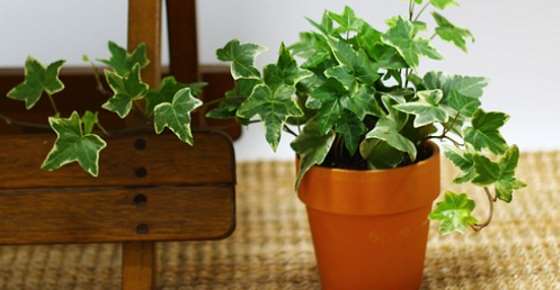
Ivy is a group of leafy plants that grow as vines climbing up structures or as creeping plants that provide ground cover. Ivies are fast-growing plants that grow just as well outdoors as they do indoors. You can plant many types of ivies to climb up walls, trellises, cover arbors, or any other structure in your garden. As an indoor houseplant, ivies can provide lush green trailing foliage in any room.
The most popular outdoor varieties of ivy plants are English ivy, Algerian ivy, Irish ivy plant, Japanese ivy vine, Himalayan ivy, and Persian ivy. Popular indoor ivy varieties include Duckfoot, Buttercup, Shamrock, and Manda’s Crested ivy.
Some common types of outdoor ivy plants such as the English ivy, Persian ivy, or Irish ivy grow well in many climates. These ivy varieties also grow well in pots if you want an easy-to-care-for plant for indoors.
In this article, you will learn about the many different varieties of ivy and how to care for them well.
Ivy Identification
Identifying species of ivy plants is usually done by the distinctive leaf shape. Generally, ivies have lobed leaves that grow alternately along climbing or trailing vines. The size, shape and color of the leaves depend on the variety of the ivy plant.
Types of Ivy: Different Types of Ivy Plants for Indoors and Outdoors (With Pictures)
Ivy is a plant in the botanical genus Hedera that produces evergreen leaves that grow quickly. Ivies are native to many countries in Europe, Africa, and Asia. Many types of ivy take their name from their native country.
Here are some of the best types of ivy plants to grow indoors or outdoors.
English Ivy
The English ivy (Hedera helix) is a flowering type of ivy that is a clinging evergreen vine. This fast-growing evergreen climbing vine quickly covers fences.
English ivy has broad large dark-green leaves that can grow up to 4″ (10 cm) long. All types of English ivy are climbing ivy plants and they can reach up to 100 ft. (30 m) in the right conditions. The ivy plant generally grows well in shady locations where there is no direct sunlight.
This flowering type of ivy produces flowers from late summer until late fall. This makes it an excellent plant for bees and butterflies that look for pollen when most other plants have stopped flowering.
English ivies also make good indoor houseplants (they are in the list of the best bedroom plants). These hanging plants require bright areas (but not direct sunlight) and moist, fertile soil. However, even if your room isn’t too bright, English ivy still grows well.
English ivy is on the list of fast spreading ground cover plants.
Goldchild ivy (variety of English ivy)
Goldchild is a popular type of English ivy that can be identified by its smaller leaves than Hedera helix but with bright yellow or gold edges. This type of variegated ivy (meaning the leaves have different colored edges) is an excellent houseplant ivy.
Ivalace ivy
Another variety of English ivy (Hedera helix) is Ivalace. This ivy climber is distinguished from other ivy varieties for its curly, shiny green leaves. Ivalace ivy is a good houseplant because of its ornamental look and it’s an easy and versatile plant to look after.
Needlepoint ivy
As its name suggests, the Needlepoint ivy (Hedera helix ‘Needlepoint’) is identified by its leaf shape with small sharply-pointed lobes. Needlepoint ivy grows well in most types of soil in shady areas. This type of English ivy looks great in hanging baskets, small containers, or as ground cover in your garden.
Algerian Ivy
The Algerian ivy (Hedera algeriensis) is a type of climbing plant that has large lobed leaves and can be an invasive type of plant.
This ivy plant also goes by the name of Canary Island Ivy or North African ivy. This broad-leafed ivy plant typically has dark green leaves, although you can also find variegated varieties. The Algerian ivy can climb up walls fairly quickly with its vines reaching up to 40 ft. (12 m).
As with many types of vine ivies, the Algerian variety grows well in most soils. Although it will grow in sunny conditions, it requires constantly moist soil to prevent its growth from being stunted.
Although this is a type of flowering ivy, the flowers and fruits are fairly inconspicuous.
Gloire de Marengo ivy
Gloire de Marengo is a variegated type of Algerian ivy with large, heart-shaped leaves. Its large leaves are greenish-gray with creamy white edges. This is a dramatic-looking ivy variety that looks good growing up walls, trellises, and slopes.
Irish Ivy Plant
The Irish ivy (Hedera Hibernica) is a great type of ivy that grow outdoors to provide ground cover or climb up walls.
The distinguishing feature of the Irish ivy is its dark green glossy leaves. This type of ivy can be quite invasive, so if you grow it in your garden, you will need to cut it back every spring. Some local authorities take steps to remove this type of ivy due to its fast growth rate.
Japanese Ivy Vine
The Japanese ivy (Hedera rhombea) is native to Asian countries and has fairly large heart-shaped leaves.
A striking feature about Japanese ivy vine leaves is the white veins running through the dark green leaves. Although this is a climber plant, it doesn’t climb as tall as some of the other types of ivies.
Japanese ivies are also a flowering type of ivy that produce small flowers in an umbrella shape. After the ivy flowers, black round fruits appear.
Usually, Japanese ivies are not cultivated for their climbing ability or ground cover but as ornamental features in gardens.
Himalayan Ivy
Native to countries in Asia, the Himalayan ivy (Hedera nepalensis) can grow at altitudes of up to 3,000 m.
The leaves of the Himalayan ivy are dark green with light-colored veins running through them. Each vine consists of elongated triangular leaves that can grow up to 6″ (15 cm) long. Some types of Himalayan ivy produce vines with very small leaves that can be as small as 1″ (3 cm).
If you are looking for a good, hardy climbing ivy, then the Himalayan ivy is a good choice. The woody vines can grow up to 100 ft. (30 m) tall. However, the ivy doesn’t provide as much cover as the English ivy varieties or the Irish ivy.
Persian Ivy
One of the fastest-growing ivies, the Persian ivy (Hedera colchica) is a good climbing ivy with large shiny leaves.
Due to the shape of the leaves, Persian ivy is sometimes called the “Bullock’s Heart” ivy. In fact, the Persian ivy produces some of the largest leaves from any of the ivy varieties. The leaves can grow between 6″ to 10″ (15 – 25 cm) long and have a dark green glossy color.
Sulphur heart ivy (type of Persian ivy)
One particular striking variety of Persian ivy is the Sulphur Heart (Hedera colchica) variety. It can be identified by its unusually large yellow and lime green leaves. This is a variegated ivy with lime green and bright gold flowers. This climbing ivy variety looks stunning growing up walls.
Canarian Ivy
The Canarian ivy (Hedera canariensis) is a woody bush-type of ivy plant that is native to North Africa and the Canary Islands.
Although some people refer to the Algerian ivy as the Canary ivy, the Canarian ivy is its own species. This type of ivy can cling to many surfaces and grow to a height of 100 ft. (30 m). The large shiny green foliage provides good dense cover. If there are no surfaces to cling to, then the Canarian ivy also provides good ground cover.
Compared to some other popular types of ivy, the Hedera canariensis grows and climbs very rapidly. You can also plant the Canarian ivy in the garden and train it to grow into a shrub or bush.
Closely related to the Canarian ivy is the Moroccan ivy (Hedera maroccana). This type of ivy also grows prevalently on the Canary Islands and is commonly found on rock faces and growing up tree trunks.
Russian Ivy
A type of ivy vine called the Russian ivy (Hedera pastuchovii) has long climbing stems and is commonly found in forests climbing up trees.
Unlike some types of ivy, the Russian ivy has thin leaves that are light green and often with wavy edges. The Russian ivy vine grows better as a climbing vine rather than a creeping ivy on the ground.
In the summertime, this becomes a flowering ivy with small white flowers that develop into small inedible fruit.
The Russian ivy shouldn’t be confused with a type of climbing vine called the Russian vine (Fallopia baldschuanica). This is also a fast-growing type of vine that produces long dangling white flowers.
Boston Ivy
The Boston ivy (Parthenocissus tricuspidata) is a type of flowering woody vine that is also called the Japanese Creeper or Woodbine.
Although the Boston ivy is commonly found on a list of popular ivies, it isn’t a true type of ivy. The reason why this type of vine is grouped with ivies is because of its climbing ability. It has fairly large leaves that provide dense coverage where it grows. Each leaf is a three-pointed light green leaf that grows between 2″ and 8″ (5 – 20 cm) across.
The Boston ivy will grow well on the facades of buildings. In fact, some building owners use Boston ivies to cover walls for shade in the summertime.
Swedish Ivy Varieties
The Swedish ivy (Plectranthus verticillatus) does not belong to the family of “true” ivy vines. It is a type of flowering plant in the same family as sage and mint and isn’t related to plants in the Hedera species.
In fact, the name “Swedish Ivy” is misleading on a number of levels. First, the trailing plant doesn’t cling to walls or surfaces. Also, the green-leafed plant isn’t native to Sweden.
Other names for the Swedish ivy are the Swedish begonia or “creeping Charlie.” The long trailing leaves mean that the plant is a good houseplant for hanging baskets.
Types of Ivy Plants for Indoors
If you are looking for indoor plants that are easy to care for, then different types of ivies are a good choice. Most ivy varieties grow in any kind of soil, don’t tolerate direct sunlight, and grow fairly quickly.
Another reason why different types of ivy plants are good house plants is that their trailing vines and variegated leaves can be an interesting feature. You can put ivies in pots on shelves, on top of cabinets, or plant them in hanging baskets. Some types of ivy plants are on the list of the best shower plants to keep in the bathroom.
The most popular type of ivy for indoors is the Hedera helix varieties, or English ivy. Here is a short list of some of the best types of ivy houseplants:
- Duckfoot is a type of English ivy with small green leaves in the shape of a duck’s foot. This indoor ivy plant has red stems and grows well in pots or containers.
- Buttercup ivy houseplants have broad yellow leaves that produce small yellowish-green flowers every year.
- Shamrock is an evergreen climbing ivy that has small leaves shaped like a shamrock. The ivy produces flowers and black berries every year and this ivy makes a good houseplant.
- Manda’s Crested is a shrub type of climbing ivy with dark green leaves that have a wavy edge. The leaves turn a bronze color in the winter.
Did you know that ivy is one of the best air filtering houseplants?
How to care for types of indoor ivy houseplants
What is the best way to care for growing ivy plants indoors?
First, your ivy needs plenty of natural light, but shouldn’t stand in direct sunlight. If variegated types of ivies don’t get enough light, you may find that they start to lose their colors.
When it comes to watering, don’t keep soil in your pots too moist. Before you water your ivy houseplant, check that the soil is on the dry side. There should be plenty of drainage from the pot to prevent the ivy standing in water.
It is also good to wash the ivy leaves once in a while to remove dust. You can do this by putting the whole plant in the shower and rinsing the leaves. This will also provide the soil with plenty of irrigation and also keep your ivy looking healthy.
Read about other amazing indoor vine plants and climbers.
Best Types of Climbing Ivy for Outdoors
Ivies are the perfect outdoor plant if you need to hide unsightly features, cover arbors, or provide shade in your garden. All varieties of outdoor ivies or vines are low-maintenance plants and tolerant of many soil conditions.
So, what are the best types of ivy for your garden? Here are a few that are great climbers:
- English ivy is a great all-around ivy for growing in your garden. The climbing vine grows tall and its large leaves provide great coverage. Plant English ivies in areas of your garden that enjoy partial shade.
- Irish ivy grows similar to the English ivy but has shinier, glossier dark green leaves.
- Algerian ivy is a hardy type of climbing ivy that can tolerate some sunshine and grows well in most types of soil.
Most ivy varieties are good for ground cover as they spread quickly. However, you need to make sure that they don’t become too invasive.
How to care for outdoor climbing ivy vines
Ivies are good to plant in areas of your garden where other outdoor plants have difficulty growing.
For all types of ivy vines to grow well outdoors, they should be planted in well-drained soil. Most varieties of ivy can withstand a range of pH levels, however, they grow best in slightly alkaline soil.
In the first year after planting your ivy, water it regularly to help establish it. Once the climbing vine is established, you only need to water it when the weather is especially dry. Try to make sure that the soil is always on the dry side and that it doesn’t become soggy.
You will need to cut back your ivy every 3 years or so to keep it under control and encourage healthy growth.
If you want to prevent climbing ivy vines from becoming too invasive, plant them in containers and place them where you want them to grow. The container pots will contain the roots and prevent them from spreading.
Related articles:

